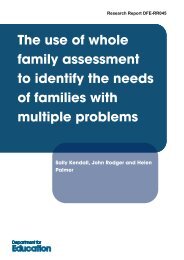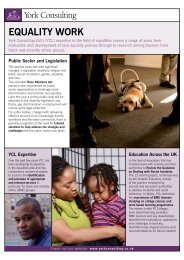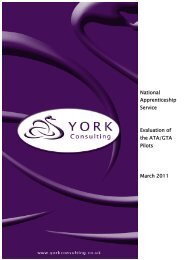Recruitment and Retention in the Post-16 Learning and Skills Sector
Recruitment and Retention in the Post-16 Learning and Skills Sector
Recruitment and Retention in the Post-16 Learning and Skills Sector
You also want an ePaper? Increase the reach of your titles
YUMPU automatically turns print PDFs into web optimized ePapers that Google loves.
• “<strong>the</strong>re is a shortage of maths tutors. Part-time contracts are notthat attractive” [Adult And Community Learn<strong>in</strong>g].Summary5.34 Key issues relat<strong>in</strong>g to vacancies <strong>and</strong> hard to fill vacancies are as follows:• <strong>the</strong>re was a 10% turnover of teach<strong>in</strong>g staff <strong>in</strong> FE. This comparesfavourably with o<strong>the</strong>r sectors. Most teachers leav<strong>in</strong>g <strong>the</strong>ir postwere tak<strong>in</strong>g a post <strong>in</strong> ano<strong>the</strong>r FE college.• <strong>the</strong> level of vacancies is low <strong>in</strong> colleges (2%), with only 11% ofcolleges <strong>in</strong>dicat<strong>in</strong>g a rate of more than 5% of teach<strong>in</strong>g/ staff.Although, nearly two fifths of colleges (38%) are experienc<strong>in</strong>g hardto fill vacancies;• two fifths of staff (40%) are aware of recruitment difficulties with<strong>in</strong><strong>the</strong>ir organisation. This was higher amongst managers comparedwith o<strong>the</strong>r members of staff. Staff work<strong>in</strong>g <strong>in</strong> fur<strong>the</strong>r educationcolleges were more likely to be aware of recruitment difficulties(50%) than respondents <strong>in</strong> all o<strong>the</strong>r organisations;• subjects where staff/HR Managers feel recruitment difficulties aremost acute <strong>in</strong>clude health/social care <strong>and</strong> public services,eng<strong>in</strong>eer<strong>in</strong>g, construction, bus<strong>in</strong>ess adm<strong>in</strong>istration;• <strong>the</strong> most common response to recruitment difficulties was to usestaff from with<strong>in</strong> <strong>the</strong> organisation to cover <strong>the</strong> job role. In a smallernumber of cases, respondents <strong>in</strong>dicated <strong>the</strong> use of agency cover<strong>and</strong> different advertis<strong>in</strong>g mediums;• just over half of staff respondents (51%) felt that <strong>the</strong> measurestaken by <strong>the</strong> organisation to cover vacancies when recruitment hadnot been successful were very or fairly effective. Teachers ofscience, English <strong>and</strong> maths were least likely to agree thatrecruitment measures had been effective;• <strong>the</strong> majority of HR Managers (86%) believe that measures to coverhard to fill vacancies have been effective;• a quarter of staff respondents felt that better pay would m<strong>in</strong>imiserecruitment difficulties with one <strong>in</strong> ten suggest<strong>in</strong>g improvements <strong>in</strong>advertis<strong>in</strong>g would be beneficial;• o<strong>the</strong>r factors mentioned by staff which might cause recruitmentdifficulties <strong>in</strong>cluded job <strong>in</strong>security, difficulties of recruit<strong>in</strong>g youngstaff, lack of suitable applicants <strong>and</strong> <strong>the</strong> negative view of <strong>the</strong> sector;48











